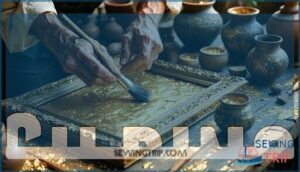This site is supported by our readers. We may earn a commission, at no cost to you, if you purchase through links.
 You’re looking at two distinct fabric personalities when comparing the antique satin difference. Antique satin rocks a matte, subdued finish that whispers elegance, while regular satin screams glamour with its mirror-like shine.
You’re looking at two distinct fabric personalities when comparing the antique satin difference. Antique satin rocks a matte, subdued finish that whispers elegance, while regular satin screams glamour with its mirror-like shine.
Think of antique satin as the sophisticated older sibling – it’s got that vintage charm with a deliberately dulled surface that won’t blind you under bright lights.
Regular satin, on the other hand, catches every ray and reflects it back like a disco ball. The texture tells the story too: antique satin feels slightly rougher and more substantial, while regular satin maintains that slippery-smooth touch.
Each serves different design purposes and aesthetic goals.
Table Of Contents
- Key Takeaways
- What is Antique Satin Fabric?
- Antique Satin Characteristics
- Where to Buy Antique Satin
- Caring for Antique Satin
- What is a Satin Finish?
- Satin Finish Vs Antique Finish
- Achieving an Antique Finish
- Achieving a Satin Finish
- Antique Vs Satin History
- Choosing Between Antique and Satin
- Frequently Asked Questions (FAQs)
- Conclusion
Key Takeaways
- You’ll spot the main difference in sheen and texture – antique satin has a matte, subdued finish with a rougher feel and distinctive slubs, while regular satin delivers a mirror-like shine with a slippery-smooth texture that catches and reflects light brilliantly.
- Antique satin isn’t actually antique – it’s a clever 1950s invention made from acetate and rayon that mimics vintage charm through modern textile techniques, while traditional satin originated in medieval China and was crafted from pure silk.
- Your project needs determine the best choice – antique satin works perfectly for upholstery, formal wear, and vintage-inspired décor where you want understated elegance, while regular satin excels for glamorous occasions and modern designs where you want maximum shine.
- Care requirements differ significantly – antique satin handles wear better and is more durable for high-traffic applications, but both fabrics need gentle handling with cold water washing and professional dry cleaning for best results.
What is Antique Satin Fabric?
Looking at antique satin, you’ll notice it’s quite different from what most people expect.
Antique satin isn’t actually antique—it’s a clever 1950s invention that captures vintage charm through modern textile wizardry.
This fabric isn’t actually antique at all – it’s a vintage invention from the 1950s that combines acetate composition with traditional satin weave techniques.
Unlike regular satin that originated in medieval China, antique satin features a reversible texture with distinctive slubs that create visual interest on both sides.
The slub differentiation sets it apart from smooth traditional satin, giving it character through intentional irregularities in the weave.
You’ll find modern applications ranging from evening wear to home décor, where its timeworn elegance adds sophistication without the fragility of genuine vintage pieces.
The acetate composition makes it more affordable than silk satin while maintaining that coveted antique finish appearance that designers love for contemporary projects.
It has a unique appearance with distinctive slubs and an intentional irregularity in the weave, making it a popular choice for various applications.
Antique Satin Characteristics
You’ll notice antique satin has distinct features that make it stand out from regular satin fabrics.
The fabric’s unique texture, slubs, and reversible design give it a vintage charm that’s both elegant and practical for various projects.
Sheen
Antique satin’s sheen tells a different story than regular satin’s mirror-like finish.
While traditional satin reflects light evenly for maximum luster, antique satin creates subtle light reflection through its unique surface texture.
You’ll notice the sheen intensity varies across the fabric, giving it character that regular satin lacks.
This uneven visual perception comes from the slubbed threads woven throughout.
The antique finish doesn’t compete for attention like glossy satin sheen – instead, it whispers elegance with understated sophistication and impressive sheen durability.
Drape
While regular satin flows like water, antique satin’s unique fiber density creates a different drape comparison altogether.
You’ll notice this vintage fabric has more body and structure than traditional satin drape. The specialized weave impact gives antique satin a fuller, more substantial fabric weight that holds its shape beautifully.
This makes it perfect for upholstery and formal wear where controlled fabric drape matters most.
Durability
Don’t let antique satin’s elegant drape fool you – this fabric’s durability tells a different story.
While its weave strength surpasses plain fabrics, the slippery texture makes it vulnerable to snags and tears.
Fiber quality varies substantially, affecting tear resistance and abrasion resistance.
Longevity factors depend heavily on care, and you’ll find fabric strength decent for formal wear, but fabric durability requires gentle handling to withstand wear properly.
Where to Buy Antique Satin
Finding the perfect antique satin for your project doesn’t have to be like searching for a needle in a haystack. You’ve got several solid options to explore, each with its own perks.
Online retailers like Paylessfabric.com and Buyfabrics.com offer the widest selection, letting you browse colors and textures from your couch. These fabric outlets typically stock antique satin by the yard at competitive prices.
For unique finds, check out Etsy’s vintage stores where crafters sell one-of-a-kind pieces. Local shops provide the hands-on experience you can’t get online.
Visit fabric stores like Joann’s or specialty boutiques to feel the texture before buying. High-end interior design showrooms often carry premium options for upholstery projects.
Don’t overlook auction sites and estate sales – they’re goldmines for authentic vintage pieces. You can find specialty satin fabrics suitable for various applications, including upholstery and bridal wear.
Whether you choose online stores or brick-and-mortar fabric purchasing, you’ll find antique satin that fits your budget and vision.
Caring for Antique Satin
You’ll need to handle antique satin more carefully than regular fabrics since its slippery texture and delicate fibers make it prone to snags and tears.
The good news is that with proper washing techniques and dry cleaning when needed, you can keep this elegant fabric looking beautiful for years to come, which is why proper washing is essential.
Washing
Hand washing your antique satin requires careful attention to preserve its delicate beauty. This vintage fabric responds best to gentle washing methods that protect its lustrous fibers from damage.
Here’s how to properly wash antique satin:
- Use cold water with mild detergent to prevent fiber damage and color fading
- Gently swish the fabric without wringing or twisting to avoid snags
- Rinse thoroughly with cool water to remove all soap residue
- Lay flat on clean towels for drying, avoiding direct sunlight exposure
Remember, antique satin care demands patience and the right water temperature for ideal results. For machine washing, use a gentle cycle with cold water to ensure the best outcome and maintain the fabric’s lustrous fibers. Always prioritize gentle washing methods and avoid direct sunlight exposure to preserve your antique satin.
Dry Cleaning
Professional cleaning works best for antique satin since dry cleaning solvents like perchloroethylene won’t damage delicate fibers.
Your local cleaner handles stain removal without water damage risks that home washing creates.
Though cleaning costs run higher than regular laundry, you’ll preserve the fabric’s lustrous finish.
Consider the environmental impact when choosing satin care methods for your vintage pieces, and think about the importance of delicate fibers and vintage pieces.
What is a Satin Finish?
Satin finish creates that smooth, polished look you’ll recognize instantly.
Unlike the weathered appearance of antique treatments, a satin finish delivers consistent satin luster across any surface.
You’ll find this versatile finish everywhere – from kitchen cabinets to jewelry pieces.
The magic happens through careful preparation and application.
Satin texture emerges when craftsmen sand surfaces with fine-grit paper, then apply clear sealers or topcoats.
This process creates the signature satin sheen level that sits perfectly between matte and high-gloss finishes.
Modern satin uses span far beyond traditional fabric applications.
You’ll see satin finish applications on wood furniture, metal fixtures, and decorative accessories.
It’s the go-to choice when you want sophistication without overwhelming shine, and a polished look that is both elegant and refined.
Satin Finish Vs Antique Finish
When you’re choosing between satin and antique finishes for wood, metal, or jewelry, you’re picking between two completely different looks that’ll change how your piece feels in any room.
Satin finishes give you that smooth, polished shine that catches light beautifully, while antique finishes create a weathered, timeworn appearance that adds character and history to your materials, providing a distinct look.
Wood
Wood finishes tell different stories through their appearance and feel.
You’ll notice antique finish creates that weathered, aged look that makes your furniture seem like it’s been passed down through generations.
It’s achieved through wood staining and distressing techniques that add character to any wood types.
Meanwhile, satin finish highlights the natural wood grain with a smooth, polished surface.
Wood polishing creates this refined look that screams modern sophistication.
Wood gilding can enhance both finishes for extra luxury.
For high traffic areas, an antique finish is often preferred due to its enhanced overall durability.
| Aspect | Antique Finish | Satin Finish |
|---|---|---|
| Appearance | Dull, weathered, aged | Bright, smooth, modern |
| Style | Traditional homes | Contemporary designs |
| Durability | More durable | Less scratch-resistant |
| Maintenance | Requires careful cleaning | Easy damp cloth cleaning |
| Touch-ups | Easier to repair | Difficult to touch up |
Your choice depends on whether you want that timeless, lived-in charm or sleek contemporary appeal.
Metal
Beyond wood applications, metal finishes showcase dramatic differences between antique and satin styles.
You’ll notice antique brass develops a rich patina over time, while satin brass maintains consistent metal sheen.
Metal durability varies substantially—antique finishes resist wear better in high-traffic areas.
For enhanced durability, consider standard fabric finishes.
Consider these key distinctions:
| Feature | Antique Finish | Satin Finish |
|---|---|---|
| Appearance | Warm, low-luster texture | Smooth, matte finish |
| Metal Patina | Develops rich character | Maintains original color |
| Metal Distressing | Pronounced, aged look | Clean, contemporary feel |
| Metal Gilding | Enhances vintage appeal | Complements modern design |
| Metal Durability | Superior wear resistance | Moderate longevity |
Jewelry
When you’re choosing between finishes for jewelry, your decision comes down to style preference.
Antique jewelry showcases rich patina that whispers stories of the past, while satin jewelry offers polished refinement for modern tastes.
Both finishes hide fingerprints well, but antique finish demands regular polishing to preserve its character.
| Feature | Antique Finish | Satin Finish |
|---|---|---|
| Appearance | Warm, low-luster texture with distressed look | Smooth matte finish with subtle sheen |
| Style Match | Traditional, vintage designs | Contemporary, minimalist aesthetics |
| Maintenance | Requires regular polishing for patina preservation | Minimal upkeep, resists tarnish effectively |
Achieving an Antique Finish
You can create an antique finish on wood, metal, or jewelry through three main techniques: staining with dark glazes, distressing to add wear marks, and gilding with gold leaf accents.
These methods work together to give your project that aged, vintage look that makes new pieces appear decades old.
Staining
Through careful application of dark glazes and stains, you’ll achieve that coveted aged appearance on wood surfaces.
This artisanal staining process creates authentic antique accents that mimic decades of natural wear. To begin, consider furniture staining products for the best results.
- Clean the surface – Remove dirt and old finishes completely
- Apply dark stain – Use brown or black glazes for depth
- Work into grain – Let stain penetrate wood fibers naturally
- Wipe selectively – Remove excess while leaving recessed areas darker
- Seal the finish – Apply clear coat for stain resistance and color fastness
Distressing
Several paint distressing techniques transform ordinary surfaces into weathered treasures. You’ll apply multiple base coats with Vaseline between layers, creating natural wear patterns where the second coat won’t stick.
Sand through these painted layers using fine-grit sandpaper, focusing on edges and raised details where authentic aging occurs. For antique satin projects, rub paint thinner over wet surfaces to remove sections strategically.
This wood antiquing method reveals underlying colors, producing texture effects that mimic decades of gentle use and handling. Exploring various distressing products can further enhance these effects, creating a truly distressed look with natural wear patterns.
Gilding
Gold leaf transforms ordinary surfaces into luxurious masterpieces when you apply thin metallic sheets using proper gilding techniques.
This traditional craft adds opulence to both wood gilding and metal gilding projects, creating stunning antique finishes that catch light beautifully.
- Surface preparation: Clean and prime your material before applying adhesive size
- Application method: Gently press gold leaf onto tacky surfaces using soft brushes
- Distressing technique: Lightly sand raised areas after gilding to reveal underlying layers
- Gilding cost factors: Quality materials and intricate details increase overall project expenses
Achieving a Satin Finish
You’ll create a satin finish by carefully sanding your surface with fine-grit sandpaper, then polishing it to achieve that smooth, gentle sheen.
This process takes patience, but it’s worth the effort since you’re building up layers that give wood or metal a clean, modern look without the high gloss.
Sanding
Perfect sanding transforms your antique satin project into something special.
Start with surface preparation—clean thoroughly and remove any debris. Select fine-grit sandpaper, typically 220-400 grit, for gentle abrading without damaging delicate fibers.
Work in one direction using even pressure, creating uniform linear strokes that enhance the fabric’s natural sheen. Proper dust control keeps your workspace clean while safety measures protect your hands and lungs.
These sanding techniques reveal the aged patina that makes distressing so effective for achieving that coveted antique finish. To further enhance the fabric, consider chemical softening options.
Polishing
When polishing for a satin finish, you’ll need the right polishing compounds and buffing wheels to achieve those perfect gloss levels.
Start with thorough surface preparation, then apply gentle, consistent pressure using proper polishing techniques.
Think of it like coaxing a shy cat—too aggressive and you’ll ruin the delicate balance.
Unlike antique satin with its distinctive patina, a true satin finish requires restraint, you’re not creating an antique finish here; you’re nurturing that subtle luster that makes satin so appealing without overdoing the shine, which is a result of proper polishing techniques.
Antique Vs Satin History
Understanding how finishes develop helps you appreciate the fascinating backstory behind these fabrics.
Satin’s journey began in medieval China’s port city of Zaitun, where skilled weavers created lustrous silk that would captivate the world.
The Silk Road carried these precious textiles westward, establishing satins Italian origins in the 12th century.
Medieval craftsmen perfected techniques that transformed heavy silk materials called samites into the flowing fabrics we’re familiar with today.
Antique satin tells a completely different story—it’s not antique at all.
This fabric emerged in the 1950s as manufacturers combined acetate warp threads with rayon weft threads, creating a textured surface that mimicked aged silk.
Unlike genuine medieval weaving traditions, antique satin invention represented modern innovation designed to capture vintage charm.
| Aspect | Traditional Satin | Antique Satin |
|---|---|---|
| Origin Period | Medieval China (12th century) | 1950s America |
| Original Materials | Pure silk | Acetate and rayon blend |
| Development | Silk Road trade routes | Modern textile engineering |
| Purpose | Luxury royal garments | Vintage-style drapery |
| Weaving Method | Hand-crafted techniques | Machine production |
Zaituns significance lives on through authentic satin history, while antique satin represents clever modern craftsmanship.
Choosing Between Antique and Satin
Now that you understand both fabrics’ rich histories, choosing between antique satin and regular satin comes down to your specific needs.
Your decision hinges on several key factors that’ll shape your project’s success.
Cost Comparison reveals satin fabric typically costs less than antique satin, making it budget-friendly for larger projects.
Maintenance Needs differ substantially – regular satin requires gentler care, while antique satin handles wear better.
Application Suitability matters too; formal wear benefits from satin’s glossy sheen, whereas home décor often favors antique satin’s textured appeal.
Knowing the weaving patterns impact care.
Consider these emotional drivers when choosing:
- Nostalgia – antique satin connects you to timeless elegance
- Practicality – regular satin offers easier maintenance
- Uniqueness – antique finish provides distinctive character
- Versatility – satin vs silk debates favor satin’s adaptability
Your Personal Preference for Aesthetic Appeal ultimately guides this choice.
Frequently Asked Questions (FAQs)
What is the difference between antique and satin finish?
Satin finish gives you a smooth, glossy modern look with gentle sheen.
Antique finish creates a weathered, aged appearance using dark stains and distressing techniques.
You’ll pay more for antique’s labor-intensive process.
What makes antique satin different from other satin fabrics?
Antique satin stands apart from regular satin through its distinctive slubbed texture and reversible design.
You’ll notice its unique bumpy surface contrasts with traditional satin’s smooth finish, creating vintage charm that’s actually a 1950s invention, with a result that is reversible.
What is antique satin end use?
Ninety percent of fashion designers choose antique satin for evening wear.
You’ll find it perfect for formal dresses, upholstery projects, and decorative accessories.
Its reversible texture works beautifully for curtains, pillow covers, and elegant home furnishings too.
What are the different types of satin?
You’ll find several distinct satin varieties: Antique satin with textured slubs, smooth Charmeuse, sturdy Duchess satin.
Reversible Crepe back satin, lightweight Messaline, affordable Polysatin, durable Baronet satin, and delicate Slipper satin for footwear.
What fabrics can be used as alternatives to antique satin?
Over 60% of fabric alternatives offer similar drape qualities to antique satin.
You can substitute with dupioni silk, taffeta, or brocade for formal wear.
Charmeuse and crepe-back satin also provide elegant alternatives with comparable luster and texture.
How do I remove stains from antique satin?
You’ll want to tackle stains immediately with gentle blotting, never rubbing.
Use cold water and mild detergent for fresh spots.
For stubborn stains, dry cleaning’s your best bet since this fabric’s delicate nature demands professional care.
Can I dye antique satin fabrics at home?
You can dye antique satin at home, but it’s tricky.
The fabric’s slippery texture and delicate fibers make it challenging.
Use cold water, gentle dyes, and test on scraps first.
Professional dyeing might yield better results.
What fabrics can achieve antique satin appearance?
Over 60% of home sewers struggle to identify fabrics that mimic antique satin’s distinctive slubbed texture.
You can achieve this look using dupioni silk, raw silk, linen blends, or cotton slub fabrics—they’ll give you that coveted vintage appearance.
How much does antique satin typically cost?
You’ll find antique satin priced between $12-35 per yard at most fabric stores.
Higher-end silk versions cost more than polyester blends.
Expect around $20-25 per yard for good quality that’ll work beautifully for your projects.
Can antique satin be used for curtains?
Yes, you can definitely use antique satin for curtains.
Its beautiful drape and elegant texture make it perfect for window treatments.
Just remember it’s delicate, so you’ll need gentle care and proper hanging techniques.
Conclusion
Ultimately, the antique satin difference boils down to your vision and project needs.
You’ve got two distinct paths: antique satin’s understated elegance perfect for formal wear and vintage-inspired projects, or regular satin’s brilliant shine ideal for glamorous occasions.
Neither’s better than the other – they’re simply different tools for different jobs.
Consider your lighting, desired aesthetic, and practical requirements.
Your choice between these fabrics will define your project’s entire personality and visual impact.



















